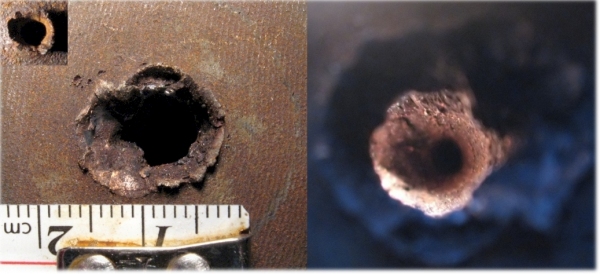Shaped charges are explosive devices that contain a cavity - usually lined with metal - surrounded by explosives that take advantage of the Munroe Effect to focus the explosive energy on a target. Shaped charges are used to cut metal, tap huge furnaces in steel mills, complete wells, initiate nuclear weapons, penetrate armor, and create art. If you look at the end result of a shaped charge on a target, you may be led to believe that the charge melted its way through the target as illustrated here:
 |
| [1] |
It looks as if the holes have been melted through the armor, but that is not the case. Experiments have been done that measured the temperature of shaped charge jets. Scientists found that the temperature of the liner material never even came close to the melting point of the material. In that case, why do the targets look like they've been melted? The velocity of the jet created by the shaped charge liner is typically between 3 and 20 km/s (6,700 - 45,000 mph). When this hypervelocity liner jet hits a target, the force is so high that the jet and the target behave like fluids. While the jet velocity is high, the two materials behave like a jet of liquid shot into a pool of water: the impact actually causes a "splash" in the target that is frozen as soon as the jet passes through. While both materials are below their melting point, the forces involved are so high that they overcome the forces holding the solids in shape. After the force is removed, the materials go back to behaving as they did before the impact. The target looks like it was melted because it was flowing like a liquid even thought its temperature was below the melting point. Looks can be deceiving, but science reveals the truth.
For a more in-depth explanation of shaped charges and similar technology, you can download
Introduction to Shaped Charges by William Walters.
The Web is full of information and nifty graphics like this one of the development of a shaped charge jet:
 |
| [2] |
Image Sources

No comments:
Post a Comment